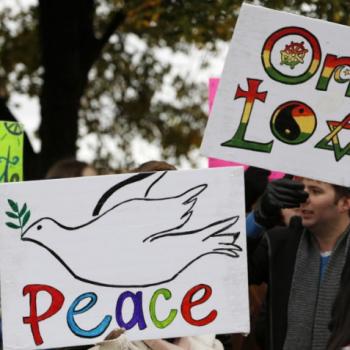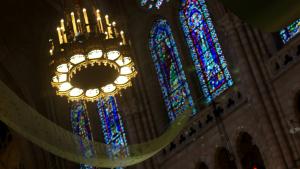Full Circle, Palm Sunday
Luke 19:28-40
Life has a funny way of coming full circle. I thought about that this week when I read a story about Randall Henry, an artist in Baton Rouge, Louisiana. Henry was being interviewed for the opening of an art show in which fourteen of his paintings were on display. The show is being held in the Kress Gallery, which was at one time the Kress Department Store. Henry’s paintings are on display there, in the spot where the Kress Department Store lunch counter used to be, the same lunch counter where Henry’s mother worked for many years. That lunch counter was also the spot where a group of Southern University students staged a sit in in 1960. Now Henry, an art professor at Southern, is showing his paintings in the same exact spot. Henry said that for him the whole experience was like history, coming full circle.
Today is Palm Sunday. It’s the final Sunday of Lent, this season of introspection and confession, and today begins the holiest week of the Christian year. From this vantage point we can look out over the next few days and we know what to expect. Jesus, entering Jerusalem, teaching his message to anybody who would listen, facing increasing opposition from those who felt threatened by him, and eventually, well, you know. If we thought before that the tension was mounting, that the story was getting more suspenseful, it’s ramped up even more in this week’s gospel account of Jesus entering Jerusalem to the cheers of a crowd.
I can’t help but notice that the date today is March 24th, so technically it has been exactly three months since we gathered here with lit candles and full hearts on Christmas Eve to read and hear the familiar story told at the very beginning of Luke’s Gospel. Remember? It starts out with a pregnant teenaged girl and ends up with shepherds on a hill at night, startled awake by the songs of angels proclaiming, “Glory to God in the highest, and peace on earth, good will toward men.”
And today our gospel lesson tells the story of a parade on the outskirts of Jerusalem. More than thirty years have passed since the angels sang on that Galilean hillside, but as we imagine the little donkey-led processional making its way up the dusty hill toward Jerusalem, we hear Luke telling us about Jesus’ disciples, gathered around and yelling at the top of their lungs, “Blessed is the king who comes in the name of the Lord! Peace! And glory in the highest heaven!”
It sounds to me like we’ve come full circle. Jesus, the prince of peace, born into humble circumstances yet poised to share the most profound message, welcomed to the world with a call for peace. Jesus, the celebrated rabbi, coming toward the seat of power, propelled by the enthusiasm of the crowd and cheered by a call for…peace.
I know there are a lot of you who have been relatively recently married (or about to be married!). I consider it my personal mission to work in opposition to the huge machine that is the wedding industry. The pressure people feel to create the most perfectly wonderful day can be crippling, right? Even for those who enter the process of planning a wedding determined not to become slaves to the incredibly powerful wedding machine, it’s hard not to get sucked in to the unrealistic expectations our society places on those who are planning weddings. All of that doesn’t technically have anything to do with what I am about to say, but I felt that since I had a captive audience I would continue my campaign.
What I am trying to say is that, on an occasion like a wedding, there are many things that people do that have symbolic meaning. You wear your wedding band on the third finger of your left hand because in the middle ages it was commonly believed that there was a vein that ran from that finger straight to your heart, a symbol then of true love. The bride wears white to symbolize purity—or joy, if the purity thing doesn’t really apply. Some people choose special flowers that symbolize different qualities they want to express in their marriage. There used to be the tradition of throwing rice to symbolize fertility (that is, before we found out that it’s bad for the birds and sometimes people slip and fall, causing accidents, the symbolism of which you probably don’t want at your wedding). Some people release doves when they get married, because doves mate for life. There’s the rose on the pew to remember Grandma and the lit candle to symbolize unity. There’s something old, something new, something borrowed, something blue…you get my point. Almost every part of a wedding ceremony is intentionally filled with symbolism.
Why?
We build symbolism into an occasion like a wedding because a wedding is an important event. Because we want to mark a day unlike other days. Because we’re trying to step outside of the regular rhythm of our lives and say to whomever is watching: this is different; this is special. It means something big.
In Luke’s version of today’s story there are layers of symbolism and allusion, as there are in the other gospel accounts, too. I mean, just think about it: Jesus presumably came in and out of Jerusalem all of the time…this particular trip to the city could have been marked in the biblical story with a simple verse, like: “Then Jesus said to his disciples, ‘Hey! Let’s go to Jerusalem! And they went.” Instead, the story is full of symbols that are meant to show us something bigger and more important than just a first century road trip is going on here.
Think about it: Jesus comes down from the Mt. of Olives, a place that was an eschatological—an end times–symbol for first century Jews. He asks his disciples to find him a colt to ride—a symbol of royalty and a reference to a prophecy in the book of Zechariah. The disciples comply and fit the colt with a saddle of their cloaks, then line the road with them, too. This is a symbolic allusion to a reference in the book of 2 Kings, when the people laid their cloaks on the ground to pave the way…for the king. Then the disciples start yelling, “Blessed is the king who comes in the name of the Lord!”—a direct quotation from the book of Psalms that implied Jesus was more than a king—he was the long-awaited Messiah, savior.
The story is told this way, rife with symbols, to send us a message: something important is about to happen. Wake up and watch! Pay attention! A king is coming, alright.
I’ve told you about this before, but I think it bears repeating. In their book, The Last Week, Marcus Borg and John Dominic Crossan say that on that same Passover eve, while Jesus rode his colt to the cheers of his disciples and others, there was another parade entering the city of Jerusalem at the very same time.
Pilate, the Roman governor usually lived in a beautiful palace on the Mediterranean coast. But as the Jewish festival of Passover approached every year, the governor always came back to Jerusalem. He had to, from a military and political perspective, because Passover seemed to embolden the Jews—after all it’s the festival that celebrates their liberation from slavery in Egypt. Since the Jews were under Roman rule, it was Pilate’s aim to make sure they didn’t get ideas of liberation in their heads, that there was no civil unrest in the city that week.
And so, every year Pilate would parade into Jerusalem in a show of military power— cavalry on horses, columns of soldiers, leather armor, helmets, weapons, banners, drums—to remind the people that their lives were ruled by power, force, and domination, that they were enslaved and that any attempts to change that would be met with violent correction.
On the opposite side of the city, in came Jesus, with all the symbolism of kingship but none of the glitz, glamor, and raw show of power in that other parade.
The people who were at Jesus’ parade didn’t miss most of the symbols, either. They joined the disciples in their cheering; they welcomed Jesus to Jerusalem like he was the next big celebrity. They were excited that finally, finally, a champion of their cause had emerged and they would soon be ushering in a new day, when they would break free from Roman rule and be, finally, independent again. But maybe in all the chaos of the parade, they missed the disciples’ calling…for peace.
Perhaps if they had stopped to listen, they may have heard that call and maybe even remembered the stories surrounding the miraculous birth of this man they were claiming as their next big political hero. If they’d remembered the angels’ song, they might have stopped to think twice about what they were expecting from this one they were calling Messiah.
A king is coming, alright, but he’s not the kind of king you expect. He’s not what you had in mind at all.
A few years ago when I finally finished my doctoral work and took my kids out of school to attend my graduation ceremony. I had the occasion to overhear one of them explaining to a friend that he would be missing school because his mother was becoming a doctor. His friend responded with some comment on the other end of the telephone conversation and my son quickly replied—“No, a different kind of doctor—not the kind of doctor that helps people.”
Jesus was a king, alright, but not the kind of king the people expected. Turns out he wasn’t the kind of king they wanted, either. His message of peace and inclusion, of loving your enemies and blessing those who curse you was not to their liking. They preferred the old way of winning and domination, enemies and violence.
And sometimes we do, too.
Sure, we’ll line the roadways for the parade, but we’ll tune out the call for peace. It’s too radical; too countercultural. It’s not what we’re used to, or even what we want some days. It’s too rigorous and too much work. Even with all that we know about who Jesus was and what he came to teach us, we still can’t get our minds around the idea that this Messiah comes, not to wage a war, but instead to do something more radical and more world-changing than even that. He comes to teach us the way of peace.
If we think back we can probably still hear echoes of the angels singing, “Glory to God in the highest and peace on earth…”, and if we were listening to the disciples’ call for peace, well then maybe we would have come full circle, wouldn’t we? But we weren’t listening. We didn’t get it. And it turns out we haven’t come full circle. Not. Quite. Yet.
Wouldn’t that have been something? If over the din of the parade they were able to hear the calls for peace and fall in behind to follow in the way of peace? But they didn’t.
And what about us?
We’ve lived these days of Lent with intention, trying to live each moment like it really matters. As we head into the week ahead, we must continue that work.
Listen hard for this radical king, Jesus, who calls us away from the lure of the world and its relentless push for power and domination, and instead toward the way of peace. His call is a call that is so radical and so uncomfortable that, if we follow his parade—it will lead us…to a cross.











